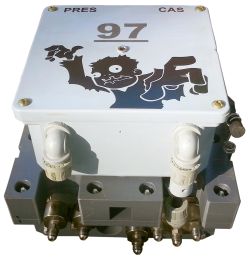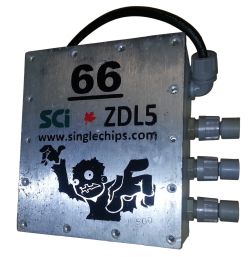PDL/CDi History Version 1.0: They Live!!! PDL5 Becomes ZDL5 Switcher!!! (Zombie Data Logger)
- Lake Erie datalogging and control operations went digital when five P7s were built and eventually installed in June, 2011. Naturally, due to the absolute superiority of the original digital P7s when compared with the P5s, it had been assumed around here that we would go forward with the digital stuff. I made two mistakes in 2011, 1) I told them the Kellers could operate in analogue mode as well as digital at the same time, and 2) although the P5 and P7 boards are very different, when the assembly is complete the two units "look" the same. As a result, instead of staying with the digital stuff and going forward from there, an apparent arbitrary decision was made, arbitrary because nobody actually asked yours truly what the difference was, so state-of-the-art Kellers were bought and made to operate in analogue mode with the old P5 boards. Sacrilege!
- The idea for the ZDL came around Halloween 2015, there was plenty of old PDL5s laying around in a "place" affectionately known around here as the "PDL Cemetery", you know, where PDLs go to die, and this place has been the cause of many laughs over the years. The good old NSC800, the CPU chip in the PDL, had gone obsolete way back in 1997 and the DS1386 RTC, the Real Time Clock, did not survive long after the year 2000 scare as it didn't have a century register, but what if the lithium battery in the RTC could be replaced, and what if the two communication lines could be switched in the UART, Universal Asynchronous Receiver Transmitter, to support a "switched" RS485 circuit? If it were possible to do those two things we could have a "digital" PDL, a PDL that "reads" the Keller transmitters digitally, one that could be supported in perpetuity.
- It was certainly worth a try, but a "switcher" PDL5 would certainly not be possible since there is a 32k program chip on the PDL5 board and the latest "switcher" program, #6214, was over 30k, in other words, there probably wasn't enough room to add the Keller digital routines to the program.
- Given the above, it would probably never had been attempted but curiosity is one hell of a motivator sometimes, and so during summer 2016 such a board was modified and the firmware/software was updated, sample1, sample2, sample3.
- Testing of the board showed great promise, the Keller singles are outstanding pressure transmitters, their performance "stunning", and all this "stunning" performance was the reason for the transformation of the CDi3.FTe, two of which were installed in sour service in early October, 2016.
- Curiosity kicked in again in the Spring of 2017, and after much code optimization, the ZDL5 Switcher was born with 200 bytes to spare in the program chip, prototype installed June 9th, 2017 at 40R.
- Since the ZDL Switcher beats the PDL Switcher in every category, and since there are upwards of 40 of these laying around in the "PDL Cemetery", nobody is laughing any more... but hey, if you want to go against the lake Erie roadmap, which now includes road signs, if you want to go backwards you can now do it in style!
Current ZDL Switcher page. The NTRM, "Nothing To Repair Man", June 22nd, 2017
Going Back to the Stone Age, 1996, and Doing so in Style!
- It was a good idea back in 1996, it still is a good idea today. "Since these industry-standard PLED things will never be used for switching, why don't we build a simple box to replace all that Stainless Steel and mess of drip pods, hoses, etc., and save 10K per unit?", "while we're at it, why don't we build our own datalogger and save even more?" Those two questions were asked sometime in 1995, but it was sometime in 1996 before the answer to both was "sure".
- The first couple of PDL1s did have limited switching capability, "limited" meaning the PDL1 could only operate a single latching solenoid, subsequent devices could do two solenoids, the first two were installed in November '96 and found alive and well in March '97. By the end of '97 the PDL3 could operate two latching solenoids with full switching capability. The rest as they say is history, PDL/CDi History Version 2.0: Pembina.
- What may be the world's simplest and least expensive, submersible, long-term natural gas flowmeter is back, outperforms the original in every category. The ZDL simple flowmeter comes with several enhancements over the original:
- Unlike the PDL5, the ZDL5 simple flowmeter doesn't have any moving parts, essentially rendering the design maintenance-free. Because of the stunning performance of the Keller singles, it doesn't have any issues related to "differential" operation. No check valves and no overpressure issues in either direction.
- The pressure transmitters are not attached directly to the box, rather they are "connected" using a few feet of cable and waterproof quick-connects, making installation underwater as easy as it can be.
- The board itself is not potted at the bottom of the box, rather it is potted in its own PVC plastic enclosure rendering the assembly essentially indestructible, even in case of a leak. If there is ever a leak, the only thing that will be destroyed is the battery and it can be changed out in a few minutes.
- Because the ZDL uses Keller singles in digital mode, it never requires calibration, the Keller singles are calibrated at the factory, the user simply chooses a pressure range from a menu.
Current ZDL Simple Flowmeter page. The NTRM, "Nothing To Repair Man", November 17th, 2017
Contact:















